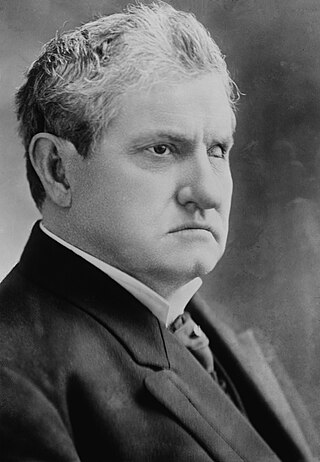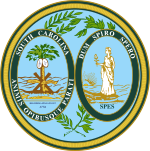
Benjamin Ryan Tillman was a politician of the Democratic Party who served as governor of South Carolina from 1890 to 1894, and as a United States Senator from 1895 until his death in 1918. A white supremacist who opposed civil rights for black Americans, Tillman led a paramilitary group of Red Shirts during South Carolina's violent 1876 election. On the floor of the U.S. Senate, he defended lynching, and frequently ridiculed black Americans in his speeches, boasting of having helped kill them during that campaign.

Coleman Livingston Blease was an American politician of the Democratic Party who served as the 89th governor of South Carolina from 1911 to 1915 and represented the state in the United States Senate from 1925 to 1931. Blease was the political heir of Benjamin Tillman. He led a political revolution in South Carolina by building a political base of white textile mill workers from the state's upcountry region. He was notorious for playing on the prejudices of Poor Whites to gain their votes and was an unrepentant white supremacist.

The 1912–13 United States Senate elections were held on various dates in various states. They were the last U.S. Senate elections before the ratification of the Seventeenth Amendment in 1913, establishing direct elections for all Senate seats. Senators had been primarily chosen by state legislatures. Senators were elected over a wide range of time throughout 1912 and 1913, and a seat may have been filled months late or remained vacant due to legislative deadlock. Some states elected their senators directly even before passage of Seventeenth Amendment. Oregon pioneered direct election and experimented with different measures over several years until it succeeded in 1907. Soon after, Nebraska followed suit and laid the foundation for other states to adopt measures reflecting the people's will. By 1912, as many as 29 states elected senators either as nominees of their party's primary or in conjunction with a general election.

The 1910 South Carolina gubernatorial election was held on November 8, 1910, to select the governor of the state of South Carolina. Coleman Livingston Blease won the Democratic primary and ran unopposed in the general election to become the 90th governor of South Carolina.
The 1912 South Carolina gubernatorial election was held on November 5, 1912, to select the governor of the state of South Carolina. Governor Coleman Livingston Blease won the Democratic primary. As South Carolina was utterly dominated by the Democratic Party, he faced no significant opposition in the general election.

The 1892 United States House of Representatives elections in South Carolina were held on November 8, 1892, to select seven Representatives for two-year terms from the state of South Carolina. Two Democratic incumbents were re-elected, four open seats were won by the Democrats and the open seat in the 7th congressional district was picked up by the Republicans. The composition of the state delegation after the election was six Democrats and one Republican.

The 1914 United States Senate election in South Carolina was held on November 3, 1914, to select the U.S. Senator from the state of South Carolina. It was the first election in South Carolina in which the voters were able to choose the candidate in the general election. Incumbent Democratic Senator Ellison D. Smith won the Democratic primary and defeated nominal opposition in the general election to win another six-year term.

The 1926 South Carolina United States Senate election was held on November 2, 1926, to select the U.S. Senator from the state of South Carolina. Incumbent Democratic Senator Ellison D. Smith won the Democratic primary and was unopposed in the general election to win another six-year term.

The 1932 United States Senate election in South Carolina was held on November 8.

The 1930 South Carolina United States Senate election was held on November 4, 1930, to select the U.S. Senator from the state of South Carolina. Incumbent Democratic Senator Coleman Livingston Blease was defeated in the Democratic primary by James F. Byrnes. He was unopposed in the general election to win a six-year term.

The 1942 South Carolina United States Senate election was held on November 3, 1942 to select the U.S. Senator from the state of South Carolina. Incumbent Senator Burnet R. Maybank defeated Eugene S. Blease in the Democratic primary and was unopposed in the general election to win a six-year term.

The 1918 South Carolina United States Senate special election was held on November 5, 1918, simultaneously with the regular senate election to select the U.S. Senator from the state of South Carolina to serve the remainder of the term for the 65th Congress. The election resulted from the death of Senator Benjamin Tillman on July 3, 1918. William P. Pollock won the Democratic primary and was unopposed in the general election to win the remaining four months of the term.

The 1918 South Carolina United States Senate election was held on Tuesday, November 5, simultaneously with the special senate election to elect the United States Senator for a six-year term from South Carolina. Nathaniel B. Dial won the Democratic primary and was unopposed in the general election to win the six-year term to the Senate.

The 1902 United States House of Representatives elections in South Carolina were held on November 4, 1902, to select seven Representatives for two-year terms from the state of South Carolina. Four incumbents were re-elected and the three open seats were retained by the Democrats. The composition of the state delegation after the election was solely Democratic.

The 1924 South Carolina United States Senate election was held on November 4, 1924, to select the U.S. Senator for a six-year term from the state of South Carolina. Coleman Livingston Blease won the Democratic primary and was unopposed in the general election to win the six-year term to the Senate.

The 1897 South Carolina United States Senate election was a unanimous election of the Democratic nominee on January 26, 1897, to select the U.S. Senator from the state of South Carolina. The Democratic primary election was held on August 26, 1896, and September 9. Prior to the ratification of the 17th Amendment to the United States Constitution, U.S. Senators were elected by the state legislature and not through the direct election by the people of the state. However, the Democratic Party of South Carolina organized primary elections for the U.S. Senate beginning in 1896 and the General Assembly would confirm the choice of the Democratic voters. Conservative Democratic Joseph H. Earle won the Democratic primary and was elected by the General Assembly for a six-year term.

The 1903 South Carolina United States Senate election, held January 27, 1903 to select the U.S. senator from the state of South Carolina, was predetermined by the Democratic Party primary election held on August 26, 1902, and September 9. Democrats were so overwhelmingly dominant that their nomination was tantamount to the general election.

The 1909 South Carolina United States Senate election was held on January 26, 1909. Its outcome was determined by a Democratic Party primary election held on August 25 and September 8, 1908. Interim Senator Frank B. Gary, who had been elected to complete the unfinished term of the late Senator Asbury Latimer, did not run for re-election. Democrat Ellison D. Smith won the Democratic primary and was elected by the General Assembly for a six-year term.

Electoral history of James F. Byrnes, 49th United States Secretary of State (1945-1947), Associate Justice of the United States Supreme Court (1941-1942), United States Senator from South Carolina (1931-1941), 104th Governor of South Carolina (1951-1955) and United States Representative from South Carolina (1911-1925)

The 1896–97 United States Senate elections were held on various dates in various states. As these U.S. Senate elections were prior to the ratification of the Seventeenth Amendment in 1913, senators were chosen by state legislatures. Senators were elected over a wide range of time throughout 1896 and 1897, and a seat may have been filled months late or remained vacant due to legislative deadlock. In these elections, terms were up for the senators in Class 3.















